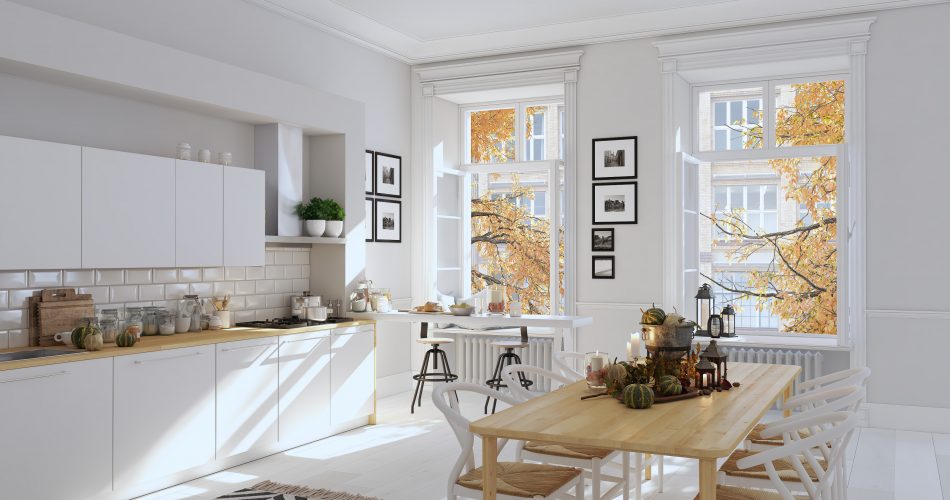There was a time, many years ago, when the kitchen was little more than an afterthought in the grand design of many homes. In effect, the kitchen existed for one solitary reason. That was to prepare and cook food. It was the domain, almost exclusively, of the cook of the house – the mother. The kitchen was a chef’s place of work and precious little else.
Of course, times change. Not only have gender roles in society changed considerably, The kitchen has evolved as a space in the family home too. So, how have kitchens progressed? How have they moved from being rooms set aside as a place of work and of food preparation to the busy social spaces they are today?
From a place of work to an entertaining space: The story of the kitchen
Even less than a hundred years ago, the kitchen was nothing more than a space for food preparation. There was certainly none of the kitchen islands, breakfast bars or open plan designs that we see today. However, over the decades the kitchen has gone through not just an evolution, but more of a revolution
What caused the change? It was a combination of the development of innovative kitchen appliances and the changing lifestyles that people lead. It means that kitchens have progressed from being a chef’s place of work. They have become modern spaces. They now offer so much more than the original purpose of the kitchen in the home. To understand where we are today in the development cycle of the kitchen, we really need to understand where we have come from.
A chef’s place of work: Kitchens back in the day
At the beginning of the twentieth century, many affluent upper-class households across the country had servants. This was fairly common amongst the upper classes, not just the landed gentry that were depicted in popular television dramas such as Downton Abbey. The kitchen was literally a preparation and service area where the servants of the house worked. The kitchen space was designed to be completely separate from the dining and social areas of the house.
The rise of the middle class gradually changed things. The era of families having servants was drawing to a close. The design of kitchens in the home got closer and closer to the main living areas of homes. As a result, they were now designed to exist without servants. From being a place of work for servants, kitchens began to be spaces that families started to use themselves.
The Open-Plan Revolution
A single design aspect led to the kitchens that we know and love today. That would would have to be the introduction of open-plan kitchens in the home. Over the years as the twentieth century progressed, the layout of the kitchen began to flow more and more into the main living areas of the home. This evolution in design basically laid the foundations for the totally open-plan home designs that are so common these days.
Cooking became more of a hobby and an interest than simply a basic need. The societal implications were massive too. Roles in the home became far less defined by gender than they had been in years gone by. Men start taking on various roles that were once reserved for women. Entertaining and cooking as a creative outlet became far more popular. The age of the dinner party was on the horizon!
The influence of technology on lifestyles
The other key factor that shaped the way we began to live our lives in the second half of the twentieth century was technology. Of course, in the last twenty years or so, life has been revolutionised because of technology. Who remembers what life was like before the internet or smartphones? But in the 1950s and 1960s, it was television that was causing the household revolution. The television cooking show was born in the sixties. Now the average man in the street began to believe that they too could create culinary delights just like the professional chefs. Fast forward a few decades and we were well into the age of the ‘TV Chef.’
As cooking and entertaining at home became all the more popular, the layout and design of kitchens began to shift some more. We were now spending much more time in the kitchen, so the work of architects and designers began to reflect these changes.
Kitchen appliances to make everything easier
The television/gaming console/media centre was soon being rivalled as the technological hub of the home too – by the kitchen. Manually-operated kitchen tools have been overtaken by electrical alternatives. From automatic electric blenders to cappuccino makers, our needs and wants have become more diverse and complicated. Technology has stepped in to provide us with the tools we need. Our kitchens have become full of devices and appliances to make our lives easier.
Kitchens have evolved to meet our changing needs
Even before the Covid lockdown forced the issue, many people were already spending more time at home. Of course, most of us still like our nights out. However, our homes have also become more welcoming and comfortable as places to entertain in recent years. Kitchens have gone from being designed for one or two people to prepare food in, or as a chef’s place of work. Now they are designed as entertaining spaces for 5-10 people socialise in.
The kitchen has become the technological hub and the beating heart of the family home. Modern life is lived in the kitchen. In fact…
The kitchen is not a place of work, it is the new living room
Kitchens were once almost exclusively for cooking, now they are very much for living. In some cases, in years gone by, the kids were told to stay out of the kitchen. It was the mother’s workspace, predominantly. Kitchens tended not to be place where the family gathered and congregated. In many smaller homes, the kitchen simply didn’t have the space for a communal table. Even in larger homes with the space to accommodate a table to have the family sat around for breakfast, ‘important’ meals were still served in the traditional dining room.
Over the last twenty years or so, homes have been designed with kitchens as living spaces in mind. In new builds, kitchens have become larger so that family and friends could be accommodated in an entertaining space. The new designs allowed space for larger spaces and islands. Much more thought is now being given to kitchen, functionality and the natural flow around the home. The new trend also saw a rise of the popularity of the kitchen extension. Homeowners of smaller properties sought to keep up with the latest trends and/or add resale value to their homes. Various studies have shown time and time again that the resale value and appeal of a property is greatly influenced by the kitchen.
There are still some people that still see having separate living and dining spaces as important. Having said that, the kitchen really has become the focal design point of many homes. There has never been more attention paid to the design, layout and functionality of the kitchen space.
The modern kitchen is much more than a kitchen
So, today’s kitchen is not just a chef’s place of work. The modern kitchen is much more than a kitchen. It may still be called the kitchen but really it is now a family living space. The kitchens of today reflect our lifestyles and help us in our desire to lead a more casual, laid back existence in the family home. Many new builds are designed without either a separate dining room or formal living areas. For those of us that live in properties which still have such rooms, we find that – if we entertain a lot – guests still tend to congregate in the kitchen. It always seems to be the place that everybody naturally moves toward.
The kitchen will continue to evolve over the coming decades. They are becoming more environmentally friendly as people become more environmentally conscious and aware. It seems likely that the kitchen will never return to the days of being seen purely as the chef’s place of work. The kitchen is so much than today. Now more than ever, the kitchen can really be what you want it to be.
When you have decided what you would like your kitchen to be, get in touch and the Kitchen Warehouse team will help you make the most of the space you have.




